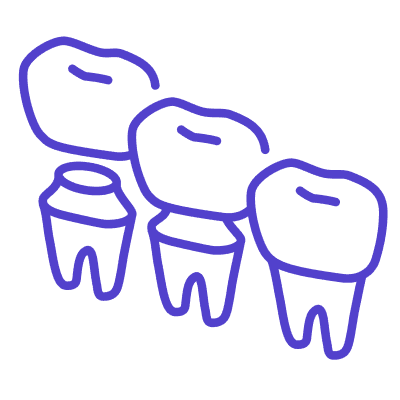Products
 Tooth type
Tooth type Crown state
Crown state Roots and canals number
Roots and canals number Root pathologies
Root pathologies Periodontium
Periodontium Tooth position
Tooth position Periradicular pathologies
Periradicular pathologies Assessment of endodontic treatment quality
Assessment of endodontic treatment quality
![[object Object], After reviewing Diagnocat's detections, the clinician can either accept or correct them.](/_next/image?url=%2F_next%2Fstatic%2Fmedia%2Fteeth-cards.c15f46e0.png&w=3840&q=75)
![[object Object], In Diagnocat’s smart dental chart, teeth are divided into several color categories: healthy, previously treated, unhealthy, missing.](/_next/image?url=%2F_next%2Fstatic%2Fmedia%2Fteeth.5b310b41.png&w=3840&q=75)

![[object Object], Red indicates pathologies, purple indicates signs of previous treatment.](/_next/image?url=%2F_next%2Fstatic%2Fmedia%2Ftooth-state.ca3e0a15.png&w=3840&q=75)
![[object Object], Teeth are illuminated yellow when the probability of caries and periapical changes is between 30% and 50%.](/_next/image?url=%2F_next%2Fstatic%2Fmedia%2Fattention-mode.98a6dfed.png&w=3840&q=75)

![[object Object], This panel includes an extensive set of automatically generated slices in three planes.](/_next/image?url=%2F_next%2Fstatic%2Fmedia%2Fautomatic.f7b07f33.png&w=3840&q=75)




Radiological Report
Diagnocat harnesses artificial intelligence to analyze CBCT scans and intraoral images.

Benefits
Diagnocat’s Screening Categories
For periapical lesions, the detection accuracy exceeds
90%

Automatic analysis takes
10 seconds for intraoral images, 30 seconds for panoramic images, and 4-6 minutes for CBCT scans
Opportunities
![[object Object], After reviewing Diagnocat's detections, the clinician can either accept or correct them.](/_next/image?url=%2F_next%2Fstatic%2Fmedia%2Fteeth-cards.c15f46e0.png&w=3840&q=75)
Comprehensive Radiological Analysis. After reviewing Diagnocat's detections, the clinician can either accept or correct them.
![[object Object], In Diagnocat’s smart dental chart, teeth are divided into several color categories: healthy, previously treated, unhealthy, missing.](/_next/image?url=%2F_next%2Fstatic%2Fmedia%2Fteeth.5b310b41.png&w=3840&q=75)
Dental Chart. In Diagnocat’s smart dental chart, teeth are divided into several color categories: healthy, previously treated, unhealthy, missing.

Diagnocat automatically creates a high-quality panoramic reformat from CBCT data, with a clear visualization the detected conditions and anatomical structures.
![[object Object], Red indicates pathologies, purple indicates signs of previous treatment.](/_next/image?url=%2F_next%2Fstatic%2Fmedia%2Ftooth-state.ca3e0a15.png&w=3840&q=75)
Tooth card status guide: Red indicates pathologies, purple indicates signs of previous treatment.
![[object Object], Teeth are illuminated yellow when the probability of caries and periapical changes is between 30% and 50%.](/_next/image?url=%2F_next%2Fstatic%2Fmedia%2Fattention-mode.98a6dfed.png&w=3840&q=75)
Suspicious teeth. Teeth are illuminated yellow when the probability of caries and periapical changes is between 30% and 50%.

Upload any study and receive a report containing up to 60 diagnostic features on CBCT scans and up to 40 on 2D images.
Our focused view offers a convenient visualization of each individual tooth to highlight a specific area of interest.
![[object Object], This panel includes an extensive set of automatically generated slices in three planes.](/_next/image?url=%2F_next%2Fstatic%2Fmedia%2Fautomatic.f7b07f33.png&w=3840&q=75)
Automatically Generated Cross-Sections. This panel includes an extensive set of automatically generated slices in three planes.
Patient-Friendly Reports
Printable Patient Reports make it easy to share clear visuals with patients right after consultations, boosting treatment acceptance by up to 23%*! Diagnocat helps patients understand their oral health and the care they need.
Download examples:

Radiological Report is used by

Single practitioners
Diagnocat analyzes radiological images, simplifies doctor-patient communication and motivates the patient to start treatment.
Learn more
Clinics
Diagnocat simplifies initial consultations, optimizes teamwork and provides analytical reports for management.
Learn more
Laboratories
Diagnocat automatically segments DICOM and creates accurate 3D models in STL format ready for export to treatment planning programs.
Learn moreCurious about Diagnocat? Explore our solutions!

Products
Specialists
This page may include information about features and capabilities that may not be available or approved for use in all regions. Regulatory clearance or approval varies by country. To confirm availability and compliance in your region, please contact us. For more legal information, please visit: legal info. Diagnocat representatives and distributors.






